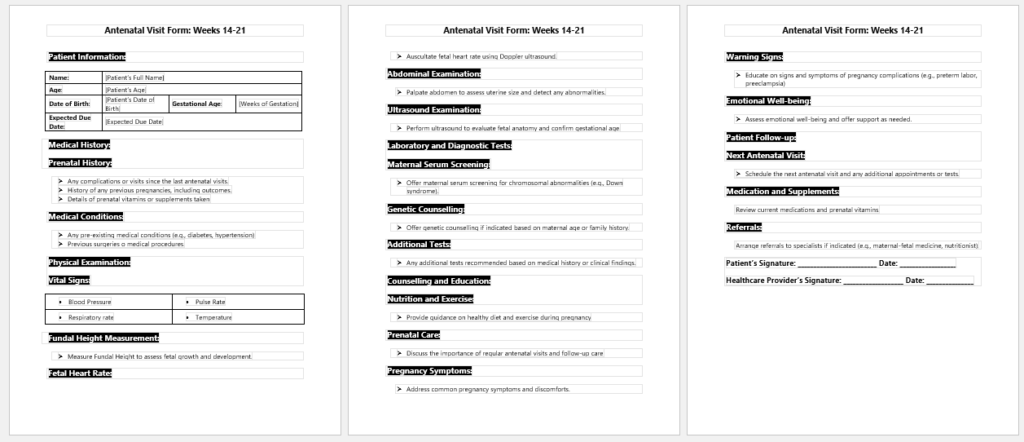This is the beginning of the second trimester of pregnancy. The fetus has started to grow in size. The placenta is now developing even better and bigger, and the position of the placenta is now well determined. Amniotic fluid is also increasing to provide a better environment for the baby inside. Along with that, the body of the mother is now showing obvious signs and effects of pregnancy. This is the time when the woman may come with several complaints and symptoms. You should take a detailed examination and take care of everything.
Antenatal Visit form (14–21 weeks)
Just like the other visit forms, it starts with the name of the doctor or midwife and the date of the examination being held. Other parameters like the weight of the mother, her blood pressure, the size of the uterus, and pelvic or perineal examination are done.
Signs and symptoms
It is time to pay heed to the complaints of the patient because she may reveal evident signs and symptoms of certain medical conditions in pregnancy, like pregnancy-induced diabetes mellitus and pregnancy-induced hypertension, which can both lead to fetal compromise.
Ask the patient if she is suffering from nausea. She must be relieved, but only a certain percentage of females suffer from it throughout their pregnancy. Swelling of the face, feet, and ankles is also noticed. She may complain of increased body aches and urinary symptoms. She may complain of vaginal leakage, which must be taken seriously.
Examination
Depending on her symptoms, we do certain examinations. As mentioned above, the physical examination is generally carried out, following the abdominal examination.
The size of the uterus is measured by abdominal examination and correlated with her gestational age according to her last menstrual period.
Baby movements must be felt by the mother by 18 to 22 weeks of pregnancy, but they may or may not be visible or palpable on examination. We can confirm the fetal heart sound with a sonic aid or through an ultrasound.
If the patient has complained of vaginal bleeding, leaking, or discharge, we need to do her per speculum examination and take the sample to confirm it in the lab. We need it for culture and sensitivity, too. Amniotic fluid leakage can be confirmed by spot dipstick tests available in most well-equipped hospitals.
Ultrasound
Abdominal ultrasound at this point is important because fetal anomalies are ruled out. The ideal gestation for an anomaly scan is 18 to 22 weeks. Down syndrome, cardiac abnormalities, renal pyelectasis, esophageal defects, skull and brain defects, and anencephaly are all diagnosed at this time, and the mother should be counseled well in time.
Laboratory investigations
A blood sugar test is done, which is very important because normal pregnancy can bring about insulin intolerance from now on. If readings are high, we can go to further tests to confirm if she has developed gestational diabetes mellitus.
Complete a blood test to check the status of hemoglobin.
A routine urinary examination is also done. Females are prone to urinary infections during pregnancy.
Follow up instructions
Information about food, supplements, level of activity, and next follow-up visit date is advised and written in the form.
- Diabetes Travel Letter
- Persmission Letter for Eatables in Office due to Diabetes
- Diabetes Letter to Employer
- Trackers for Medical Facilities
- Nursing Documentation Templates
- Letters for being Unfit to Travel
- Mental Health Evaluation Forms
- Forms Used by Pediatricians
- Various Forms Related to Pregnancy Verification
- Common Forms Used by ENT Specialists
- Patient Registration Confirmation Messages
- Quotation Letter for Medical Services
- Mental Health Letter by Doctor
- Excuse Letter for Absence due to Medical Checkup
- Response Letter to Feedback on Improvement in Hospital



